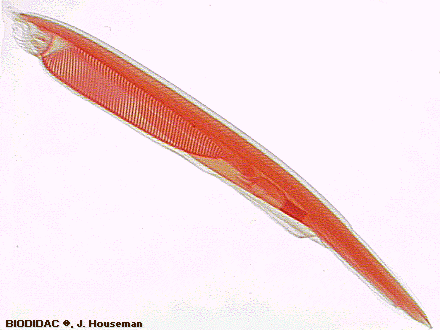BIOL Lab 191 - Chordates
1/14
There's no tags or description
Looks like no tags are added yet.
Name | Mastery | Learn | Test | Matching | Spaced |
|---|
No study sessions yet.
15 Terms
what are the four characteristics that the members of the Chordata phyla share at some point in their life?
notochord, dorsal hollow nerve chord, pharyngeal slits, postanal tails
what are some of the additional traits characterized by the Chordata phyla? (not the main four)
jointed appendages, segmentation

what subphyla does this belong to?
Cephalochordata
what features did the Vertebrate phyla evolve to have?
vertebral column, cranium, endoskeleton, neural crest, internal organs (circulatory and excretory system), joint appendages
what is oviparous?
birth process where young hatch from an egg
what is viviparous?
birth process where young are born live
what is ovoviviparous?
birth process where young develop halfway in egg, egg hatches in womb, and are given birth to live
what is a clasper?
structure on chondrichthyes that allows males to transfer sperm
what is the symmetry, tissue organization, body cavity and bastula development status of all chordates?
bilateral, triploblastic, coelemate, deuterostomes
what are the three bird feather types?
contour, down, filoplume
what are the three different ways frogs take in oxygen?
gills, lungs, or through skin
what are the three mammal subgroups?
monotremes, marsupials, placental mamals
what sets monotremes apart from other mammals?
oviparous birth, have a cloaca
what sets marsupials apart from other animals?
births young very underdeveloped; transfer to mothers pouch and finish development there
what sets placental mammals apart from other animals?
young are born fully developed and are nourished young with mothers milk